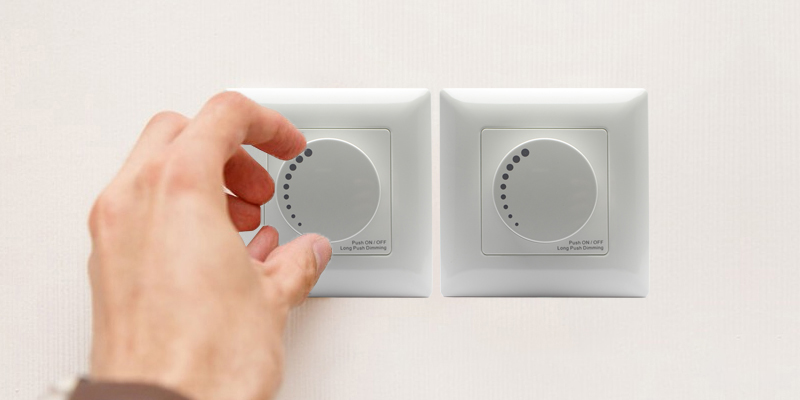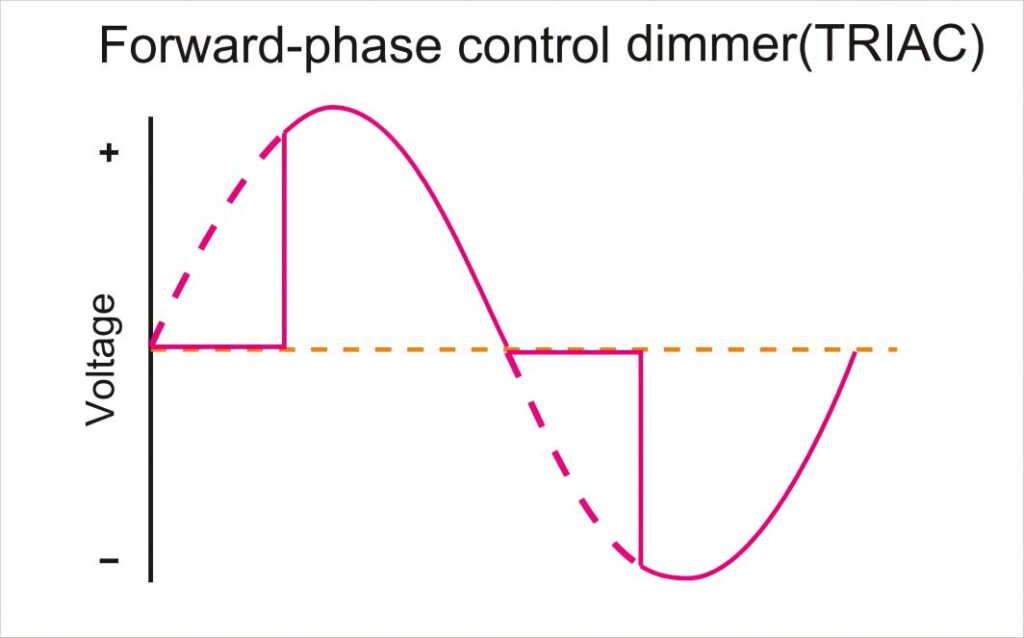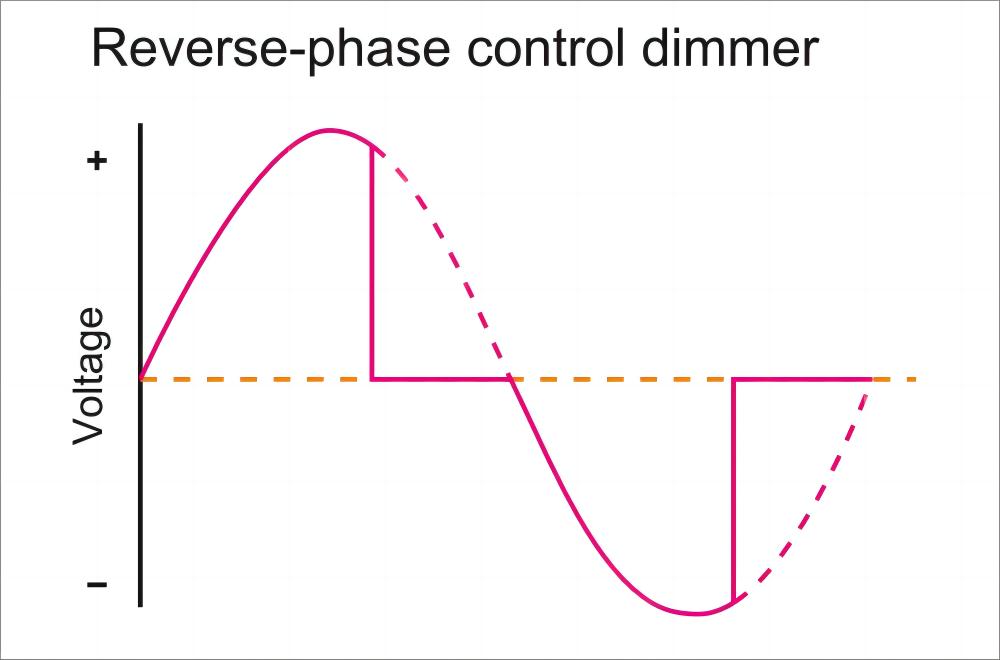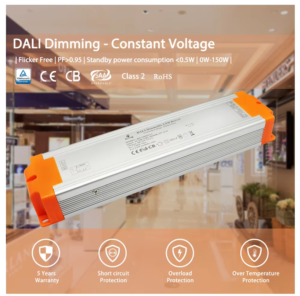Einführung
Mit der Weiterentwicklung der Beleuchtungstechnologie ist die Möglichkeit, die Helligkeit zu steuern, sowohl in Wohn- als auch in Geschäftsräumen unerlässlich geworden. Dimmer ermöglichen eine flexible Beleuchtungssteuerung und helfen dabei, die gewünschte Atmosphäre zu schaffen und die Energieeffizienz zu fördern. Eine der beliebtesten Arten von Dimmern ist der TRIAC-Dimmer. TRIAC-Dimmer sind für ihre Erschwinglichkeit, Einfachheit und Kompatibilität mit herkömmlichen Lichtquellen bekannt und eignen sich ideal für eine Reihe von Anwendungen.

In diesem umfassenden Leitfaden erklären wir, was ein TRIAC-Dimmer ist, wie er funktioniert und wie er im Vergleich zu anderen Dimmtechnologien abschneidet. Am Ende werden Sie die Vorteile und Grenzen von TRIAC-Dimmern kennen und wissen, ob sie für Ihre Beleuchtungsanforderungen geeignet sind.
A TRIAC dimmer is a type of phase-cut dimmer that controls lighting brightness by modulating the power sent to the light. "TRIAC" stands for "Triode for Alternating Current," a semiconductor ideal for alternating current (AC) circuits, as it regulates current in both directions, making it a popular choice for residential and commercial dimming.
Was ist ein TRIAC-Dimmer?
A TRIAC-Dimmer (short for "Triode for Alternating Current") is an electronic device used to control light intensity by adjusting the power sent to the light. TRIAC dimmers are a form of Phasenanschnittdimmung Technologie, bei der Teile der AC-Wellenform (Wechselstrom) abgeschnitten werden, um die dem Licht zugeführte Energie zu reduzieren und so die Helligkeit zu steuern.

Im Gegensatz zu Widerstandsdimmern, die die Leistung einfach durch Hinzufügen von Widerstand zum Stromkreis reduzieren, schalten TRIAC-Dimmer den Strom zu verschiedenen Zeitpunkten innerhalb jedes Wechselstromzyklus schnell ein und aus. Durch die Steuerung des Stromflusses zum Licht wird die Helligkeit effektiv moduliert, ohne viel Energie zu verschwenden. TRIACs sind zum Standard für viele private und kleine gewerbliche Dimmanwendungen geworden, insbesondere für Glühbirnen und Halogenlampen.
Bestandteile eines TRIAC-Dimmers
TRIAC-Dimmer bestehen in der Regel aus mehreren Kernkomponenten:
- Thyristor (TRIAC): Die Schlüsselkomponente, die den Stromfluss steuert und quasi als Ein-Aus-Schalter innerhalb des Stromkreises fungiert.
- Kondensatoren: Sie regeln das Timing innerhalb des Stromkreises und bestimmen, wann Strom fließen soll.
- Potentiometer: Dieses Bauteil steuert den Widerstand, der wiederum die Helligkeit durch die Einstellung des Zeitpunkts innerhalb des Wechselstromzyklus regelt, an dem der Strom abgegeben wird.

Zusammen ermöglichen diese Komponenten dem TRIAC-Dimmer, variable Lichtstärken auf energieeffiziente Weise zu erzeugen.
Wie funktioniert ein TRIAC-Dimmer?
TRIAC-Dimmer arbeiten mit Phasentrenntechnik. Hier erfahren Sie, wie sie die Helligkeit im Detail steuern:
- AC-Zyklus: In einem Wechselstromkreis wechselt die Spannungswellenform 60 Mal pro Sekunde (in Nordamerika) oder 50 Mal pro Sekunde (in Europa) zwischen positiven und negativen Phasen. Diese konstante Fluktuation bildet die Grundlage für das TRIAC-Dimmen.
- Phasentrennung: Instead of delivering a continuous flow of electricity, the TRIAC dimmer "chops" sections of the AC waveform. By cutting off sections of the wave, it controls the amount of power reaching the light, thereby dimming it.
- Dimmen an vorderster Front: Die meisten TRIAC-Dimmer arbeiten nach dem Prinzip der Phasenanschnittdimmung. Das heißt, sie schalten den Strom zu Beginn eines jeden Wechselstromzyklus ab und schalten ihn zu einem Zeitpunkt wieder ein, der durch die Dimmeinstellung des Benutzers bestimmt wird. Je mehr die Wellenform abgeschnitten wird, desto schwächer wird das Licht.

Arten von TRIAC-Dimmschaltern
TRIAC-Dimmer gibt es in verschiedenen Ausführungen, die auf unterschiedliche Anwendungsfälle zugeschnitten sind:
- Drehbare Dimmer: Diese in Wohnräumen üblichen Dimmer verwenden einen Drehknopf zur Steuerung der Helligkeit.
- Schiebe-Dimmer: Sie verfügen über einen Schiebeschalter zur Einstellung der Lichtstärke und werden häufig in Wohnungen und Büros eingesetzt.
- Intelligente Dimmer: Sie werden über Smartphones oder Hausautomatisierungssysteme gesteuert und lassen sich für zusätzlichen Komfort in Smart-Home-Einrichtungen integrieren.
- Ferngesteuerte Dimmer: Bedienung mit kabellosen Fernbedienungen, ideal für größere Räume oder Umgebungen, in denen ein Fernzugriff gewünscht ist.
Jeder Typ bietet eine einzigartige Benutzererfahrung, obwohl alle auf der gleichen zugrunde liegenden TRIAC-Technologie arbeiten.
Anwendungen von TRIAC-Dimmern
TRIAC-Dimmer sind vielseitig einsetzbar und eignen sich für verschiedene Beleuchtungsanwendungen, darunter:
- Wohnräume: TRIAC-Dimmer sind in Haushalten beliebt, um eine angenehme Beleuchtung in Wohn-, Ess- und Schlafzimmern zu schaffen. Sie ermöglichen es den Hausbesitzern, das Ambiente zu steuern und die Räume je nach Bedarf entspannender oder anregender zu gestalten.
- Kommerzielle Räume: In Einrichtungen wie Restaurants, Einzelhandelsgeschäften und Hotels ermöglichen TRIAC-Dimmer eine individuelle Anpassung der Beleuchtung an verschiedene Tageszeiten oder Veranstaltungen. Durch die Anpassung der Helligkeit können Geschäftsinhaber Energiekosten einsparen und ihren Kunden eine einladende Umgebung bieten.
- Industrielle Anwendungen: TRIAC-Dimmer sind zwar in industriellen Umgebungen weniger verbreitet, können aber in Lagern, Werkstätten und Fabriken eingesetzt werden, um die Beleuchtung zu steuern, die Sicht zu verbessern und den Energieverbrauch zu senken.
- Veranstaltungsorte für Unterhaltung: TRIAC-Dimmer werden auch in Theatern, Auditorien und anderen Unterhaltungsräumen eingesetzt, wo eine präzise Beleuchtungssteuerung erforderlich ist, um eine bestimmte Stimmung zu erzeugen.
Ist ein Lutron-Dimmer ein TRIAC-Dimmer?
Lutron ist eine bekannte Marke, die eine breite Palette von Dimmern anbietet, von denen viele die auf TRIACs basieren. Modelle wie das PD-6WCL und PD-10NXD nutzen die TRIAC-Technologie für die Kompatibilität mit Glühbirnen und Halogenlampen. Lutron-Dimmer sind für ihre Zuverlässigkeit und einfache Installation bekannt und lassen sich nahtlos in private und gewerbliche Beleuchtungssysteme integrieren.
Lutron stellt auch Dimmer her, die mit LEDs kompatibel sind, aber es ist wichtig zu wissen, dass nicht alle TRIAC-Dimmer mit LEDs funktionieren, da sie unterschiedliche Leistungsanforderungen haben. Prüfen Sie immer die Kompatibilität eines bestimmten Lutron-Dimmers mit der Art der Beleuchtung, die Sie verwenden möchten.
Was ist der Unterschied zwischen einem TRIAC-Dimmer und einem ELV-Dimmer?
ELV-Dimmer (elektronische Niederspannungsdimmer) sind eine weitere Art von Dimmern, die über gegenphasiges Dimmen. Im Gegensatz zu TRIAC-Dimmern, die den Strom zu Beginn des Wechselstromzyklus unterbrechen, unterbrechen ELV-Dimmer den Strom am Ende jedes Zyklus. Dieser Ansatz führt zu sanfteren Lichtübergängen und geringerem Verschleiß der LED-Treiber, wodurch ELV-Dimmer besser mit LEDs kompatibel sind.
- TRIAC-Dimmer: Am besten geeignet für Glühbirnen und Halogenlampen, mit geringeren Kosten und einfacherer Technik.
- ELV-Dimmer: Ideal für LED-Beleuchtung, sorgt für sanftes Dimmen, weniger Stromstöße und höhere Effizienz.
Während ELV-Dimmer Vorteile für LED-Anlagen bieten, sind TRIAC-Dimmer aufgrund ihrer Kosteneffizienz und Zuverlässigkeit nach wie vor für traditionelle Beleuchtungsarten beliebt.
Ist ein TRIAC-Dimmer führend oder nachlaufend?
TRIAC-Dimmer sind fast immer modernste Dimmer. Beim Vordimmen unterbricht der Dimmer die Stromzufuhr am Anfang der Wechselstromwellenform. Diese Methode liefert einen Stromstoß, der für Glühbirnen und Halogenlampen geeignet ist, die diesen Stromstößen standhalten können.
Bei LED-Beleuchtung kann dieser Stromstoß jedoch zu Flackern, verkürzter Lebensdauer oder suboptimaler Dimmleistung führen. LEDs funktionieren am besten mit . oder das Dimmen in umgekehrter Phase, wie es bei ELV-Dimmern der Fall ist, so dass die Kompatibilität immer bestätigt werden sollte.


Wie man feststellt, ob ein Dimmer ein TRIAC ist
Um festzustellen, ob es sich bei einem Dimmer um einen TRIAC-Dimmer handelt, achten Sie auf die folgenden Indikatoren:
- Produktkennzeichnung: Viele Hersteller geben auf der Verpackung "TRIAC" oder "leading-edge" an.
- Informationen zur Kompatibilität: In den Produktspezifikationen werden oft kompatible Beleuchtungsarten angegeben; TRIAC-Dimmer führen in der Regel Glühbirnen oder Halogenlampen auf und können auch LED-Kompatibilität angeben.
- Physikalische Merkmale: TRIAC-Dimmer sind oft für die Bedienung mit einem Drehknopf oder Schieberegler ausgelegt, wie sie für herkömmliche Dimmvorrichtungen typisch sind.
- Technische Daten: Check for terms like "phase-cut" or "leading-edge" in online product descriptions or manuals.
Vorteile von TRIAC-Dimmern
TRIAC-Dimmer bieten mehrere deutliche Vorteile:
- Erschwinglichkeit: TRIAC-Dimmer sind im Allgemeinen kostengünstiger als andere Dimmtechnologien und daher für verschiedene Budgets erschwinglich.
- Benutzerfreundlichkeit: Sie sind einfach zu installieren und zu bedienen und daher sowohl für Heimwerker als auch für Profis geeignet.
- Breite Kompatibilität: TRIAC-Dimmer funktionieren gut mit Glühbirnen und Halogenlampen und ermöglichen ein sanftes Dimmen für herkömmliche Beleuchtungsanlagen.
Nachteile von TRIAC-Dimmern
Trotz ihrer Vorteile haben TRIAC-Dimmer ihre Grenzen, insbesondere bei der Verwendung von LED-Beleuchtung:
- Lärm: Einige TRIAC-Dimmer erzeugen ein leichtes Summen oder Brummen, insbesondere beim Dimmen auf niedrige Werte.
- Probleme mit der Kompatibilität: TRIAC-Dimmer sind nicht universell mit allen LEDs kompatibel, was zu möglichem Flackern oder begrenztem Dimmen führt.
- Geringere Energie-Effizienz: Während die TRIAC-Dimmung bei Glühbirnen effizient ist, ist sie bei LEDs im Vergleich zu anderen Methoden wie ELV oder PWM nicht so energieeffizient.
Vergleich mit anderen Dimmtechnologien
Das TRIAC-Dimmen ist nur eine der Möglichkeiten auf dem Markt. Hier sehen Sie, wie sie im Vergleich zu anderen gängigen Methoden abschneidet:
- PWM (Impulsbreitenmodulation): Die bei LED-Beleuchtung übliche PWM-Dimmung passt die Helligkeit durch schnelles Ein- und Ausschalten des Lichts an und sorgt so für sanfte Übergänge und hohe Effizienz.
- 0-10V Dimmen: Die häufig in Geschäftsräumen eingesetzte 0-10-V-Dimmung ermöglicht eine gleichmäßige Dimmsteuerung für LED- und Leuchtstofflampen.
- Digitale Steuerungssysteme (DALI, DMX): Moderne Systeme wie DALI (Digital Addressable Lighting Interface) und DMX ermöglichen eine komplexe Beleuchtungssteuerung, die häufig in großen kommerziellen, industriellen und Unterhaltungseinrichtungen eingesetzt wird.
Fortgeschrittene Beleuchtungssysteme: DALI und DMX
DALI und DMX sind digitale Beleuchtungssteuerungssysteme, die sich für größere Anlagen eignen oder wenn eine präzise, programmierbare Beleuchtung erforderlich ist. Sie bieten eine fortschrittlichere Steuerung als das TRIAC-Dimmen und ermöglichen es dem Benutzer, zahlreiche Leuchten zu steuern, Farben einzustellen und spezifische Lichtszenen zu erstellen.
Diese Systeme sind zwar teurer und komplexer, eignen sich aber ideal für Räume wie Theater, Einkaufszentren und hochwertige Wohnprojekte.
Die Wahl des richtigen Dimmers für Ihre Bedürfnisse
Die Wahl des richtigen Dimmers hängt von der Art der Beleuchtung, dem Budget und dem Platz ab. Hier ist ein kurzer Leitfaden:
- Glühbirnen und Halogenlampen: Verwenden Sie einen TRIAC-Dimmer, da er kostengünstig und einfach zu bedienen ist.
- LED-Beleuchtung: Entscheiden Sie sich für einen ELV- oder LED-spezifischen TRIAC-Dimmer, um Kompatibilitätsprobleme zu vermeiden.
- Komplexe Installationen: Ziehen Sie DALI- oder DMX-Systeme für eine erweiterte, programmierbare Steuerung in Betracht.
Die Beratung durch einen Fachmann kann auch die Kompatibilität mit Ihrem Beleuchtungstyp und Ihren Energiezielen sicherstellen.
Zukünftige Trends in der Dimmtechnik
Mit dem Aufkommen von intelligente Häuser und IoT-TechnologieDimmersysteme entwickeln sich rasch weiter. Intelligente Dimmer ermöglichen eine ferngesteuerte und programmierbare Steuerung und lassen sich in Hausautomatisierungssysteme integrieren. Während TRIAC-Dimmer nach wie vor beliebt sind, werden digitale Steuersysteme und App-basiertes Dimmen wahrscheinlich die Zukunft der Beleuchtung bestimmen.
Schlussfolgerung
TRIAC-Dimmer sind eine erschwingliche, benutzerfreundliche Lösung für die Beleuchtungssteuerung in Haushalten und kleinen Unternehmen. Sie bieten Flexibilität, Energieeinsparungen und Kompatibilität mit vielen herkömmlichen Beleuchtungstypen. Mit dem Fortschritt der LED-Technologie und der Smart-Home-Integration können Benutzer jedoch alternative Dimmlösungen für eine bessere Effizienz und Anpassungsfähigkeit in Betracht ziehen.






